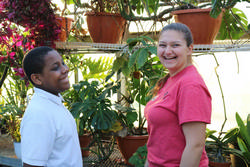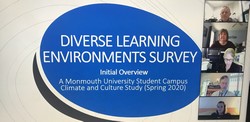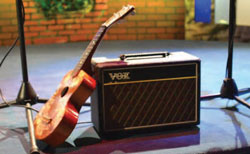Monmouth University began hosting nature-based workshops for the social practice project, Discovering the Ecological Self, this February to encourage a connection between the middle school students from the Aslan Youth Ministry (AYM) and the environment, through art and science.
The project is developed and led by artist Kimberly Callas, MFA, an assistant professor in the department of art and design. The purpose of these workshops is to foster environmental stewardship and create environmental leaders and Social Practice artists, according to Callas.
AYM is an after school program based in Red Bank that provides middle school children from underprivileged backgrounds with resources for guidance, tutoring, mentoring, recreational activities, and cultural enrichment programs.
Some of the students enrolled in the AYM programs have been returning to the University every Wednesday from 4:00 p.m. to 6:00 p.m. where they receive an interactive learning experience focused on marine biology.
“We live so close to the beach, it just makes sense that we would want to connect the students with the ecosystem, that for many, they have known and loved for much of their lives,” said Callas.
Students from the marine biology and environmental policy department, members of the Artists for Change club, and students in Callas’ Sculpture 2 class connect with Callas and ecologist specialist and associate professor of biology Pedram Daneshgar, Ph.D., leading and supporting the various weekly activities.
The workshops generally begin with a science lesson done by marine biology and environmental policy student volunteers Rebecca Klee, senior, and Taylor Donovan, a junior.
“It seems like the kids are really into it, they ask a lot of science questions and it is great because they can hang out, do art, and learn science for a couple of hours,” said Klee. “I think its beneficial for them because they come from underprivileged neighborhoods where they may not have these opportunities otherwise. At the end of the day, this gives them a social thing to do and they get the opportunity to learn here, where they could be doing maybe not so great things at home.”
At last Wednesday’s lesson, the students were learning about algae (seaweed) in the ocean. Where it grows, what animals eat it, what products it is in, why it is important to the eco-system and the food chain, and how humans consume and interact with it. The week prior the students learned about bioluminescence in the ocean and used black paper and neon chalks to reproduce the effects of glowing marine life.
Following the biology lesson, the students learn basic building block concepts of art. In the case of seaweed, the students learned about lines, rhythm, repetition, patterns, and movement expressed through art, and were then shown examples of professional artwork done with natural materials and of nature itself, specifically seaweed. Historical examples from 1500 B.C. as well as more recently produced pieces were shown, an example being a pastel on paper piece by Georgia O’Keeffe, 1938.
Daneshgar then showed the students how pressing plants with paper is a form of preserving plant life, observing it with great detail, and making art as well. At this time, he showed the students multiple examples, some from as far back as 1937. While analyzing one piece, he pointed out that the thorns of a rose are a way for roses to protect themselves as one example and helped the students understand more about ecology.
After the students received the brief interactive lesson, they went to tour the university green house where the volunteers helped students clip pieces of plants from their stems in the green house to create their own pressings of plants they found the most interesting looking.
Amanda Green, President of Artists for Change, and a senior fine arts student said, “I like to see how kids take the information and make art out of it, everyone has a different interpretation and it’s very exciting to see what the kids come up with. It is an interesting and hands on way to connect art and nature for the students. A lot of us art students are still figuring out how to connect the two ourselves.”
The project received a grant from the Urban Coast Institute’s (UCI) Marine Science and Policy Initiative Program (MSPI) for this spring semester. According to Thomas Herrington, Ph.D., the associate director of the UCI, this grant is awarded to faculty who propose projects that educate and advance the core mission of pursuing a healthy and productive costal ecosystem and community.
“We do believe that this project will improve future environmental conservation. We can only improve our coastal environment and communities when people understand their connection to the coastal environment and the value that environment has to them,” said Herrington.
“Multi-disciplined studies like professor Callas’ that combine art, environment, and the coast, are much more likely to lead to broad connections that benefit society than just a scientific understanding can do alone,” Herrington continued.
According to Callas, Discovering the Ecological Self stemmed from her personal sculpture project Portrait of the Ecological Self which came out of her work in sustainability. Callas had spent years practicing ecological art, and running a sustainability institute in Maine, with similar social practice projects and research.
With the desire to create sustainable change, Callas was discouraged when observing that few people were responding to environmental data from scientists.
“I noticed that even those opposed to environmentalism would protect a stream they had fished in as a child. We protect what we love. Art can access our more emotional connection to nature and re-awaken our love for our natural home,” said Callas.
Discovering the Ecological Self is also being studied by Megan Delaney, Ph.D., LPC, and an assistant professor in the counseling program of Monmouth’s graduate school. Delaney is a practicing counselor who has focused on eco-therapy and related research in her studies and career and has implemented this form of therapy by taking her students and clients outside to re-connect with nature.
Delaney will be doing a two-part study on the project, first by administering pre and post surveys to collect hard data measuring the Aslin Ministries and Monmouth student’s relationship with and opinions of the environment to draw the correlation between the program and the evidence of improved desire for environmental stewardship.
“The hypothesis is that the students will develop a deep connection with the natural world, and on a personal level think of themselves, Kimberly uses this sword, as ‘environmental stewards’. It will hopefully light a fire in them,” said Delaney.
The second aspect of the study will be qualitative, which will allow for Delaney to gather meaning based date through student’s testimonials detailing the experience with the project, and how their feelings towards the environment has or has not changed.
At the conclusion of the study the research will potentially be published and presented.
“Part of eco-therapy is give and take, what we take, we also give back. With conservation and protection, we hypothesis that the stewardship will be augmented,” said Delaney.
PHOTO TAKEN by Joy Morgan




